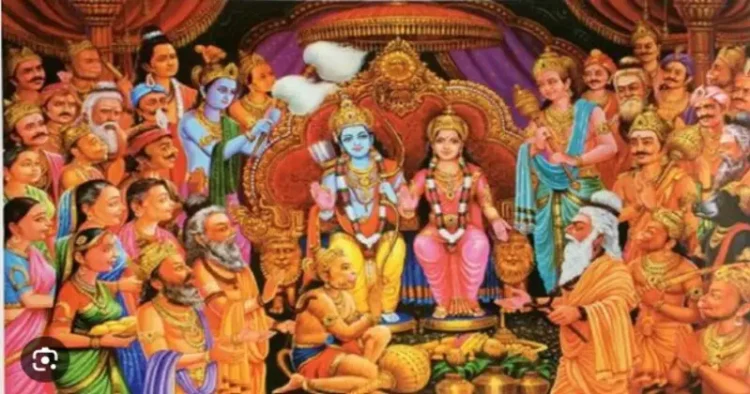‘Rajya of Ram’ as a model form of good governance that tells us about ‘The Kingdom of Ram’, there was no starvation, soreness or discrimination among the people. Bhagwan Ram Kingdom is based on truthfulness, without violence, and other ethical principles.According to Ram Rajya, a leader is expected to look after everyone who needs help and support instead of accumulating wealth for himself. Ram Rajya goes beyond the ideas of socialism and capitalism and pertains to ‘No corruption’. The Ramayana easily teaches us that what is right, goes along with the elders in the family and the philosophers, scholars, and intellectuals of society
The concept of ‘governance’ is not new; it is as old as human civilization. Simply put ‘governance’ means the process of decision-making and the process by which decisions are implemented. The governance process must also be just, reasonable, fair, and citizen-caring.
Ram’s system of administration was a true democracy. He was an ideal king: self-disciplined, obedient, dutiful, patient, dignified, a man of word, law-abiding, and a great coordinaton. The main characteristic of Ramarajya was that it covered all aspects of democracy. There was a likelihood of getting justice. The Ramayana is India’s national idea and is a symbol of good governance, which we lack in modern societies.
Dimensions of good governance according to the Ramayana
Variation and inclusiveness
Bhagwan Sri Ram organised and conducted a team with a belligerent Laxman, mighty Sugreev, excitable monkeys, peaceful and collected Jamwant, Vibhishan, and Bhakt Hanuman. The most important feature was that he heard all of their divergent perspectives, viewpoints, and plans of action and took integrative judgement, which was all inclusive but had an eccentric process from his own awareness.
Whistle bluster of Vibhishan
These days, whistle-bluster is very valuable for transparency and moral manners in administration. If we look into Ramayan, we had one of the greatest whistleblowers of all time, Vibhishan. He questioned the immoral execution of Ravan and raised his voice against it many times. But the most important point is that all was done with a sense of maturity, respect, and in a calm and composed manner. He maintained sanctity and neither wanted to capture Lanka nor oust Ravan. Also, his aim was not to defame Ravan. He wanted Ravan to be an ethical leader and lead Lanka for a long time, and for this, Ravan’s behaviour and actions were needed to be righteous.
Succession-related matters
• Even before victorious over Lanka, Sri Ram declared that Vibhishan would be the natural successor of Ravan. He did not even want to stay in Lanka for a second after liberating Mata Sita from Ravan. He said to Lakshman, This golden Lanka does not interest me; mother and motherland are loftier than heaven.
• When Vibhishan’s Rajtilak was done, he said, It comes obviously to me that if I win any empire, I don’t pillage its wealth, but try to begin good initiatives there.
Loksangrah
The socially responsible leadership of Raja Janak has been a hallmark of the Bharatiya approach to development. When a leader follows the karmayog path in nishkaam karm mode, it results in self-development as well as the development of the organisation or society. The trusteeship model is a similar approach that ensures that the organisation contributes to the development of society.
Ram’s philosophy
• Ram’s philosophy was that the ultimate Dharma was doing good to the people.
• There was no greater adharma than causing others to suffer.
• The Ram’s Principle is a combination of the divine in the human and the human in the divine.
• The inspiring story of Ram presents the triple ethical code relating to the individual, the family, and society. If society is to progress properly, the family should be happy, harmonious, and united. For unity in the family, the individuals composing it must have a spirit of sacrifice.
• Ramarajya, as has been described in the Ramayana, had all the characteristics of democracy. In the eyes of the law, all, whether rich or poor, a royal or a beggar, were the same. Everyone enjoyed the socio-religious freedom. Although Ram was the ruler, every person had a right to speak his or her mind. It set a high standard of ethical and moral conduct. There was a likelihood of getting justice. That is why Mahatma Gandhi acknowledged Ramarajya as a true democracy. In his own words, “In the Ramarajya, the meanest citizen could be sure of swift justice without an elaborate and costly procedure. Even the dog is described by the poet as having received justice under Ramarajya.
Diplomacy
India’s foreign minister, Dr S Jaishankar, has termed Bhagwan Krishma of the Mahabharata and Bhagwan Hanuman the greatest diplomats. Hanuman was on a diplomatic mission to Sri Lanka to know the whereabouts of Mata Sita. He did not only gather information about her but also became successful in contacting Mata Sita. This episode reflects how aptly Ram selected Hanuman for the diplomatic mission. Apart from the spiritual and religious lives of people, the Ramayana is today playing an important role in pursuing India’s foreign policy. India’s Ramayana and Buddhist circuits are twin pillars that support the Modi government’s policy of building strategic bridges with neighbours in East and Southeast Asia. In short, the Ramayana plays a valuable role in supporting India’s Act East Policy.




















Comments